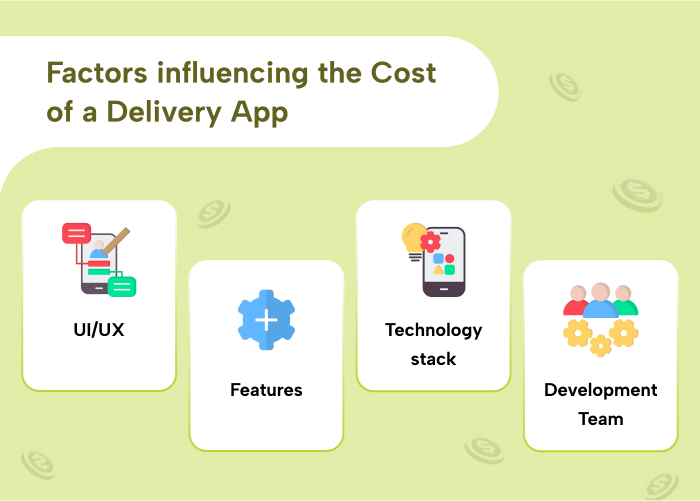Factors influencing the cost of a delivery app

The cost of a grocery delivery app depends on various factors including the complexity of the apps, integrations, technologies, etc. Let’s look into the details of the app development cost:
- UI/UX: The design elements add to the overall development cost. Furthermore, adding animations to the app and creating graphics will add to the cost of the app.
- Features: Adding complex features to the app increases the cost of development. The main reason for this is the time taken to develop the features and functionalities like payment features, real-time integrations, and the hired experienced developer.
- Technology stack: The tech stack was chosen for developing the app for different platforms like iOS and Android. For example, the cost of developing a cross-platform app would be cheaper than native application development.
- Development Team: The location of the development team also influences the cost of development of a grocery delivery app. For instance, the pay rate of the developers would be higher in the USA compared to India.
Must-have features in a grocery delivery app
- User login: With this feature, users can create their accounts, and manage their order history and personal information.
- Store search: This functionality helps in searching the stores nearby with geo-location integration.
- Product Catalog: It allows the users to browse the products and add them to their shopping carts.
- Ratings: Adding reviews and ratings is an important feature of a grocery delivery app. It helps users to get an idea of the product quality and the service offered by the stores.
- Discounts: The app should also have discounts for users to use the coupons while shopping from their favorite stores.
Steps to build a daily consumable products delivery app
- Note the objectives: The first step to creating an app would be defining the objectives. Determine the core features your app will offer, such as user registration, product browsing, order placement, payment processing, etc.
- Design UI/UX: Design a user-friendly interface for both customers and delivery personnel. Make sure that the design is responsive.
- Choose the Tech stack: Consider factors such as scalability, speed, and security while selecting the tech stack.
- Development: Develop the app using technologies like React Native for cross-platform mobile development or Swift/Kotlin for native iOS/Android. Build the backend infrastructure to handle user authentication, product management, order processing, etc.
- Testing: Conduct thorough testing of the app to identify and fix bugs. Perform functional testing, usability testing, performance testing, and security testing.
- Launch: Deploy the app to the respective app stores (Apple App Store, Google Play Store). Develop a marketing strategy to promote the app and attract users.
- Update: Gather user feedback and analyze the grocery delivery app’s usage data. Continuously iterate on the app by adding new features, optimizing existing ones, and addressing user concerns. Stay updated with technology trends and market demands to remain competitive.
- Support and maintenance: Provide ongoing maintenance and technical support to ensure the app runs smoothly. Furthermore, regularly update the app with bug fixes, security patches, and new features.
Conclusion
A thorough process that includes market research, design, development, testing, launch, iteration, and continuous maintenance is involved in creating a grocery delivery app. You can develop a profitable grocery delivery app that satisfies the demands of your target market and maintains your competitive edge by following the instructions provided in this blog post.
FAQs
How long does it take to build a grocery delivery app?
What are the essential features of a grocery delivery app?
How do I ensure the security of customer data in the app?
How can I attract users to my grocery delivery app?
What should I do after launching the app?
Ravi Bhojani is the Chief Marketing Officer (CMO) at Alian Software, where he spearheads the company’s marketing strategies and drives its brand presence in the competitive IT services landscape. With over a decade of experience in the technology and marketing sectors, Ravi has consistently demonstrated his ability to blend innovative marketing techniques with deep industry knowledge to deliver outstanding results.